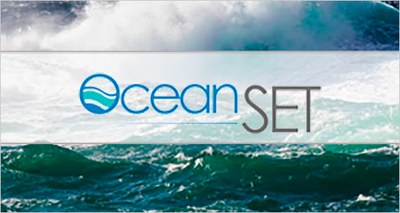Marine energy: Mediterranean, new ENEA models for hi-resolution waves and tides forecasts
3/10/2019
 Estimating sea energy production thanks to high resolution forecasts of waves and tides of the Mediterranean. ENEA has developed MITO[1], a model of water circulation forecasting temperature, salinity and speed of sea currents with a spatial detail ranging from 2 km to a few hundred meters as in the case of the straits of Gibraltar, the Dardanelles and the Bosphorus. As for waves, a forecasting system – Wawes - guaranteeing a resolution of up to 800 meters in marine and coastal areas with high energy potential was created[2]. Both utilize the ENEA supercomputer "CRESCO6, performing 1.4 million billion operations per second.
Estimating sea energy production thanks to high resolution forecasts of waves and tides of the Mediterranean. ENEA has developed MITO[1], a model of water circulation forecasting temperature, salinity and speed of sea currents with a spatial detail ranging from 2 km to a few hundred meters as in the case of the straits of Gibraltar, the Dardanelles and the Bosphorus. As for waves, a forecasting system – Wawes - guaranteeing a resolution of up to 800 meters in marine and coastal areas with high energy potential was created[2]. Both utilize the ENEA supercomputer "CRESCO6, performing 1.4 million billion operations per second.
"In the Mediterranean the areas with the highest wave energy potential are the western coasts of Sardinia and Corsica, the Sicilian Channel and the coastal areas of Algeria and Tunisia, where the average energy flow fluctuates between 10 and 13 kW / m.
In addition to the waves in our model we have now included local tides and those transmitted from the Atlantic through the Strait of Gibraltar. This will provide additional information on the state of the sea and its circulation, improving our forecasts on energy production and the assessment of the impact on some economic sectors such as tourism, transport and maritime trade ", Gianmaria Sannino, Head of the ENEA Laboratory for Climate Modeling and Impacts, explained.
In Italy, tidal energy can be harnessed mainly in the Strait of Messina. This area shares with the Strait of Gibraltar the record of most promising site of the Mediterranean: in fact, thanks to the exploitation of its currents, that reach speeds exceeding 2 meters per second, energy production could reach 125 GW / h per year, an amount sufficient to meet the energy needs of a city like Messina. In our Country the interest for sea energy exploitation is growing, particularly of waves, since energy extraction from tides is limited to a single geographical area and the technology has a greater level of maturity. The initiatives in this sector are multiplying, but the most significant at the public level concern the Electric System Research and the recent establishment of the National Technological Cluster Blue Italian Growth (BIG). The development of marine renewable energy is a driving force for the economic growth and the re-launch of our shipbuilding industry chain. ENEA, together with the Polytechnic of Turin, is responsible for the activities related to marine renewable energy.at the Scientific-Technical Council of the BIG-Cluster.
Currently in Europe there are test facilities for energy power from the sea with an installed power of a few MW. By 2050 10% of the European Union's energy needs will be covered by this new energy source thanks to a production of 100GW, powering 76 million households and avoiding 276 million tons of CO2 released nto the atmosphere every year. In order to achieve this goal, the SET Plan - the EU program for the energy sector – has set the development of commercial technologies for the exploitation of currents at 2025 and those for waves at 2030, with an estimated reduction of kWh costs (20 ct € / kWh in 2025, 15 ct € / kWh in 2030 and 10 ct € / kWh in 2035).
The initiative presented at the “Ocean Energy Europe Conference & Exhibition in Dublin” from September 30th to October 1st. "In Europe there are countries like Scotland and Ireland [3]- the latter is the coordinator of OceanSET – advanced in sea-energy technology development .
With this new initiative we will assess technologies and financing mechanisms active in each state to promote shared knowledge on this new source of clean energy, with which Europe could gain global leadership with a potential turnover of over 50 billion euro a year and the creation of 400 thousand new jobs.
Italy is the most technologically advanced country in the Mediterranean. Several devices are now undergoing advanced experimentation; most of these prototypes were designed to exploit at best the Mediterranean 'energy field', where the waves are of small height and high frequency, and to respect its delicate marine ecosystem", concluded Sannino, who represents Italy in the OceanSET project and is responsible for the sector "energy from the sea" in the SET Plan.
For more information please contact:
Gianmaria Sannino, ENEA – Head Laboratory “Climate Modeling and Impacts””, gianmaria.sannino@enea.it
Modelli MITO e Waves: https://giotto.casaccia.enea.it
OceanSET: https://www.oceanset.eu/
[1] MITO - Massachusetts Institute of Technology Operativo - si basa su un modello sviluppato dal MIT di Boston.
[2] Sardegna occidentale, Stretto di Messina, Civitavecchia, Golfo di Napoli, di Genova e di la Spezia, mar Ligure e isole di Pantelleria, Lampedusa ed Elba.
[3] Sustainable Energy Authority of Ireland (Irlanda); Wave Energy Scotland e The University of Edinburgh (Scozia); Direção Geral de Energia e Geologia (Portogallo); France Energies Marines (Francia); Ocean Energy Europe (Belgio); Ente Vasco de la Energía (Spagna);
